What Is Tiger's Blood Syrup And How Is It Used?

The name seem a little off-putting, and the intense red color jarring, but it's hard to deny the deliciousness of tiger's blood syrup. Known variously as tiger's blood, tiger blood, and tigers blood, this tropical, fruity flavoring comes in many forms and varieties, and is most often used to make fluffy, fruity shaved ice (or shave ice, without the d, as it's known in Hawai'i) and in snow cones.
The vague and poetic name of this flavoring invites experimentation, but the base recipe consists of watermelon and strawberry with a subtle addition of coconut. No one really knows how this bright and bouncy combination of fruit flavors took on such a heavy metal moniker, but since the 1980s this summery concoction has been one of the more popular flavors for snow cones and shaved ice around, so clearly the odd name doesn't drive people away.
Curious to learn more about this sweet summertime treat with the strangely sanguine name? Read on to dig deeper into the world of tiger's blood syrup.
Read more: 17 Discontinued Sodas We Aren't Getting Back
What Is Tiger's Blood Syrup?
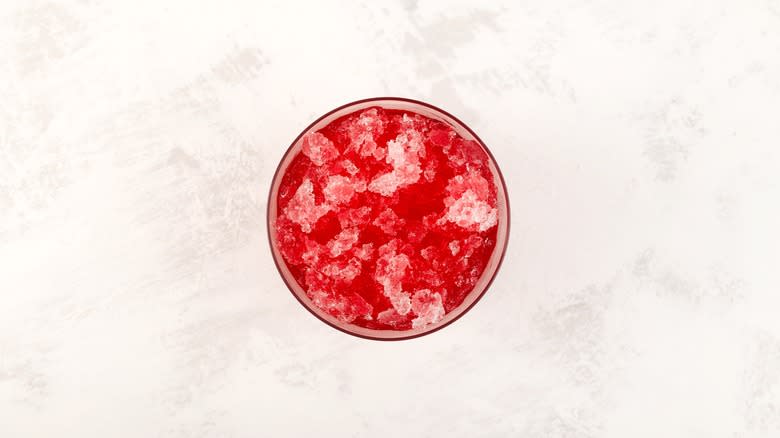
Tiger's blood syrup is a substance that's a bit hard to define, because there's no one specific form it takes. It's almost always bright, almost neon red in color, but can also have a more natural hue, a deep crimson shade, or be completely colorless. Generally speaking, when you come across a syrup labeled as tiger's blood, it will be strawberry, watermelon, and coconut, but it may also contain other fruit flavors as well. Some brands add pineapple, some add cherry, and some omit the watermelon.
No matter which kind you've got, tiger's blood syrup is always sweet and fruity. That sweetness and fruitiness can be natural, but in most commercial brands, it's usually artificial. Since tiger's blood is most often used to flavor ice, it's typically highly concentrated so that it still provides intense flavor even when diluted. As a commercial product, it's often sold in various sizes of plastic bottles and jugs.
What Does Tiger's Blood Syrup Taste Like?
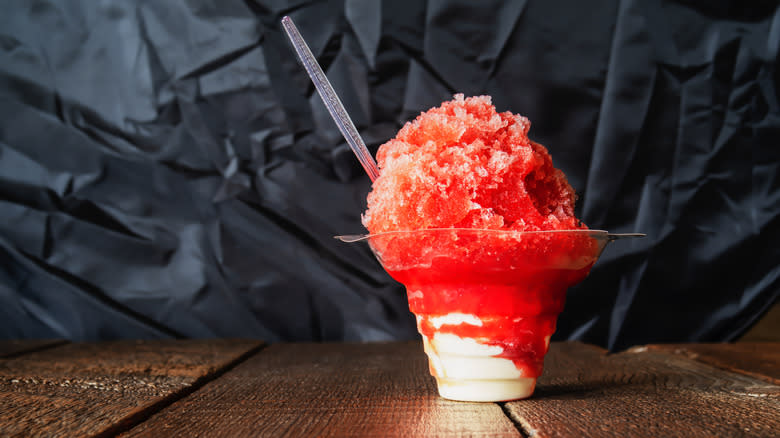
When you ask for something made with tiger's blood flavor, there's no guarantee exactly what you're going to get. You can be certain it will include strawberry and some coconut, and you can reasonably assume that watermelon will be involved. Other than that, tiger's blood as a flavor is really about vibes: bright, tropical, sweet, and summery.
Sweetness and concentration will vary, with some commercial syrups containing tons of sugar and supercharged flavor, while other syrups may have a more natural, subtle flavor. The quality of ingredients can have a lot to do with how it tastes -- some brands use high fructose corn syrup, others use cane sugar, and others use sugar substitutes as their sweetening agent. Since the syrup is not meant to be consumed on its own, it can be very strongly flavored and unpleasantly sweet if you try to enjoy it that way. Tiger's blood syrup is crafted to add flavor to other ingredients, hence its intense concentration.
Where Did Tiger's Blood Originate?
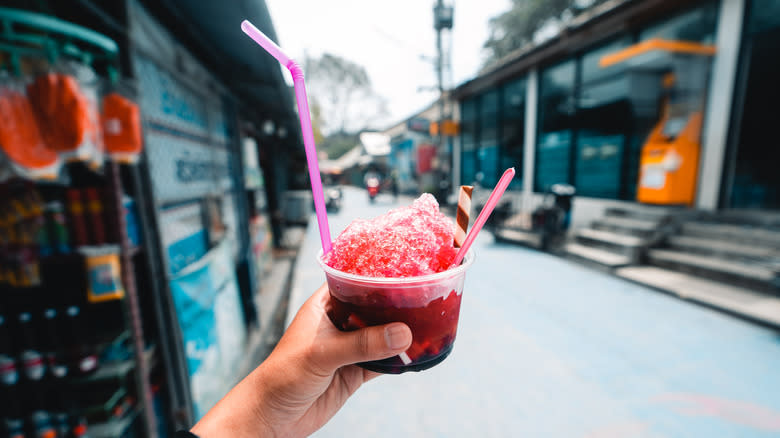
You might think that something with such an unusual and memorable name would have a well-established backstory, but the true origins of tiger's blood are shrouded in mystery. The flavor began to pop up in the 1980s, but exactly where it was invented is unknown. Two likely candidates for its origin are Texas and Hawai'i, places where flavored icy treats are something of a local delicacy. Once the flavor combination became popular, it took off nationally and even internationally, making its original source even harder to track down.
Despite these murky beginnings, tiger's blood syrup is most closely associated with the islands of Hawai'i (despite the fact that there are no tigers there). You can find the flavor in just about every shave ice shop in the state. The refreshing treat hit the islands via Japan, as immigrants brought over kakigori, a Japanese specialty consisting of hand-shaved ice, juice, and sugar. Since kakigori has been around for centuries, it's entirely possible someone way back in time created a flavor combination similar to tiger's blood long before it's assumed invention in the 1980s. We'll never know, but the flavor's enigmatic origin adds to its charm.
How Is Tiger's Blood Syrup Made?

Tiger's blood syrup can be made using many different methods. Commercial syrups from major brands are mass-produced in factories, which can make ten thousand bottles a day or more. Ingredients typically include sugar or high fructose corn syrup, or a sugar substitute such as stevia, along with artificial or natural flavorings and preservatives. These are the kinds of syrups you'll find at shaved ice or snow cone shops, carts, and kiosks. Since they're used by professionals, they're meant to have stability, consistent flavor, and a long shelf life.
There are several methods that can be used to make your own tiger's blood syrup at home. The easiest way is to find and mix flavored syrups to create your own combination -- many syrup brands such as Torani make watermelon, strawberry, and coconut flavors which can be melded together to fit your personal taste. A second method involves flavored drink mixes like Kool-Aid, which can be added to store-bought or homemade simple syrup, made with just sugar and water. Fruit juices can also be mixed and reduced to create tiger's blood syrup, although watermelon, strawberry, and coconut juices may not be easy to find.
The most labor and time-consuming method, but arguably the one with the best results, is making the syrup from scratch using fresh fruit. Pureed fruit cooked down with sugar and water will create the most fresh-tasting and naturally flavorful tiger's blood syrup. It can be strained or left chunky.
How To Use Tiger's Blood Syrup
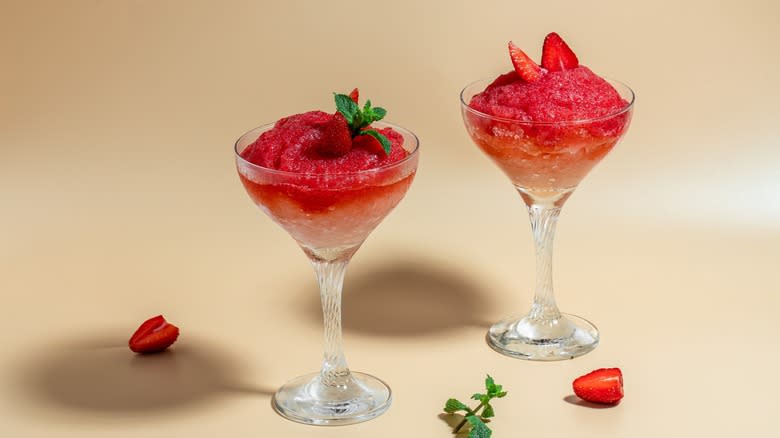
Tiger's blood syrup's traditional use is as a flavoring for shaved ice and snow cones, and it truly shines in this capacity, adding delightfully bright, summery fruitiness to these treats. Shaved ice is lighter and fluffier, lending the syrup's flavors delicacy, while snow cone ice has a crunchy texture, letting the intensity of the flavors pop. Tiger's blood syrup makes a tasty popsicle, too, and can be used as the flavoring base for ice cream and sorbet (don't forget the cornstarch to make them extra creamy).
This fruity concoction is not just for icy desserts though, being great in beverages of all kinds: A spoonful stirred into lemonade or iced tea gives a blast of sweet, fruity flavor, and added to seltzer or sparkling water it makes a refreshing beverage. For the grown-ups, tiger's blood can be used in cocktails and mocktails, whether adding a few drops into a vodka and soda or building an intricate Tiki-inspired tropical boozy work of art.
Using tiger's blood syrup in baked goods is an easy way to bring that fruity tropical character to cookies, cakes, muffins, or scones -- just be sure to adjust the sugar content or the syrup could make things too sweet. For a crunchy treat, it can even be used to flavor popcorn. Just coat freshly made popcorn in the syrup, sprinkle it with salt, and let it dry. The crunchy, sweet, and salty combination is tough to beat.
Varieties Of Tiger's Blood Syrup

The main two types of tiger's blood syrup are commercially produced and homemade. It would be impossible to go over every variation of homemade syrup, as there are infinite possibilities, since you can tweak each ingredient and flavor to your exact liking. Generally speaking, you can divide them into two categories based on flavor: There's the traditional tiger's blood syrup which is made with only watermelon, strawberry, and coconut, and there are more exotic variations, which can have additional fruits and other flavors like ginger or vanilla.
Commercially made syrups can vary based on the sweetening agent used. While many brands are made with high fructose corn syrup, others use sugar, such as the Hypothermias brand tiger's blood, which boasts that it's made with only pure cane sugar. The same company also makes a sugar free variety that's sweetened with monk fruit, and you can find other brands with various sugar free options as well, which use sweeteners like stevia or allulose. There are commercial dye-free syrups, too, that allow you to either leave the syrup colorless or add your own artistic flair by coloring it yourself -- consider using natural coloring ingredients, which can add interesting flavors as well as vibrant hues.
Where To Buy Tiger's Blood Syrup
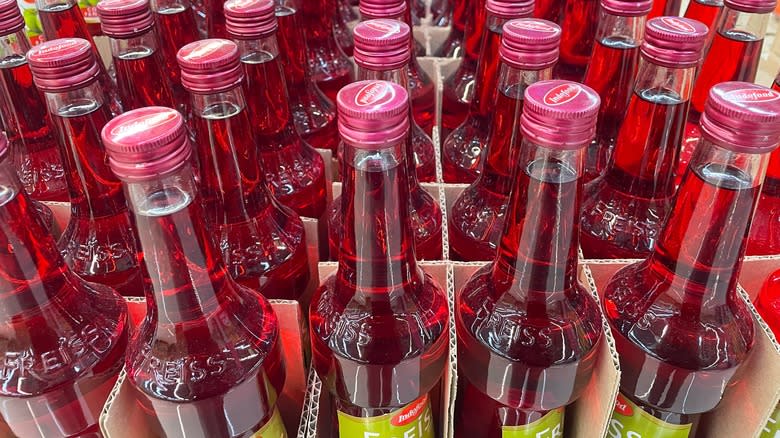
There are plenty of tiger's blood syrup brands out there, and lots of different varieties are available to purchase online. Many commercial snow cone suppliers offer syrups for purchase by retail customers as well as industry professionals. Amazon offers dozens of brands as well. Most come in sizes as small as a pint, which would be suitable for home use, all the way up to a gallon or more -- probably not necessary for the average consumer, but if you are having a large party, or make snow cones or shaved ice frequently, the larger sizes might end up being more economical.
If you prefer to shop in person, you can typically find tiger's blood syrup, along with other flavored syrups, at large grocery stores such as Walmart. Restaurant supply stores are another good place in which find them, although with these, it's always a good idea to call ahead first to make sure they have the flavor you're looking for.
How To Store Tiger's Blood Syrup

Commercially produced tiger's blood syrups are made with shelf stability in mind. The addition of preservatives and the method of production ensure that these types of syrups can last a long time, often a year or more. Many commercially available syrups do not need to be refrigerated, but they will last longer this way, especially after the container has been opened. Exposure to oxygen can cause the flavors to deteriorate more quickly, so it's always best to keep the bottle sealed when not in use.
Homemade syrups will not last as long. Depending on the ingredients and methods used, their shelf lives can vary greatly. A syrup made with fresh fruit has the shortest lifespan, and definitely needs refrigeration to avoid food spoilage. A simple syrup-based tiger's blood will last a week in the refrigerator, although there are ways to extend a fruit syrup's life up to a year. Those made with store-bought syrups or powdered drink mixes will typically outlast those made with fresh fruit, especially if refrigerated, but care should still be taken before consuming. Syrups can become moldy, so if you notice anything unusual looking, or pick up on any off smells, it's best to dispose of the syrup.
Nutritional Information About Tiger's Blood Syrup
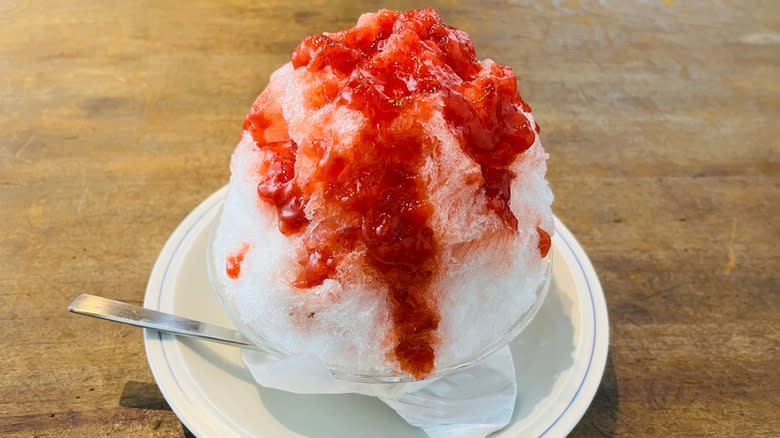
The nutritional content of tiger's blood syrup varies wildly depending on whether it's industrially produced or handmade, and of course what kinds of ingredients are used. As an example, the brand Hypothermias makes several different versions of the syrup. Their traditional syrup that's made with cane sugar has 50 calories per serving, five milligrams of sodium, and 14 grams of carbohydrates, most of which are from added sugars. Their sugar free monkfruit-sweetened option has only five calories per serving, with eight grams of carbohydrates.
While commercial syrups lack any meaningful nutritional value, syrups made with fresh fruit will have added health benefits in comparison. Both watermelons and strawberries contain plenty of vitamin C, which is a boon for the immune system, can help to lower high blood pressure, and boasts many other healthy effects. Both fruits also contain potassium, another blood pressure regulator. Fresh watermelon also contains important vitamin A and B5 (also known as pantothenic acid), along with the mineral copper, while strawberries contain good amounts of vitamin B9 (folate) and manganese. Fresh coconut contains antioxidants and many beneficial minerals.
While homemade fresh fruit syrup will likely have a similar calorie and carbohydrate content to the commercial stuff, you'll get the additional advantage of the vitamins and nutrients present in the ingredients. You can lower both calories and carbs in your homemade syrup, too, if you swap out the sugar for a sugar substitute.
Don't Confuse Tiger's Blood Syrup With These Other Items
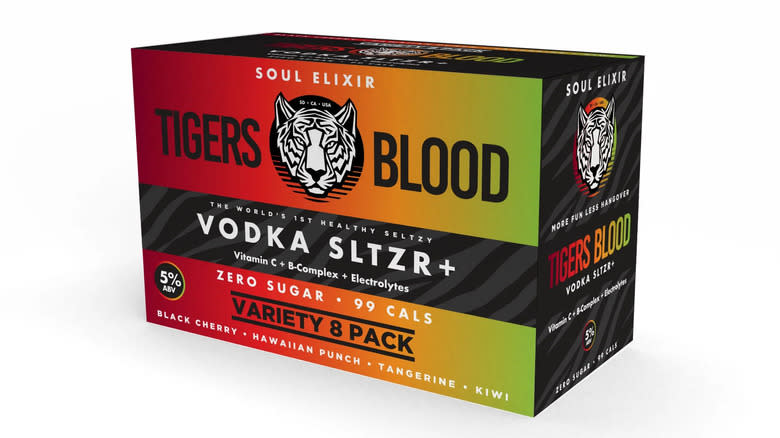
The terms "tiger's blood," "tigers blood," and "tiger blood" can be found on all sorts of products, not just flavored syrups. It can help to be aware of these items so that you don't end up with a product you don't want -- there's nothing worse than jonesing for a fruity snow cone, only to find what you thought was a flavored syrup is actually an energy drink. The phrase entered pop culture consciousness in 2011 when actor Charlie Sheen used the term during a wildly incoherent interview that went viral, and it didn't take long for a company to turn it into a money-making opportunity by marketing an energy drink called Tiger Blood. While Sheen's interview has largely faded from collective memory, the phrase has lived on, gracing items from flavored vodkas to hard seltzers to dietary supplements.
The folks behind the popular Whole30 diet trend took the phrase "tiger blood" to describe a specific phase of the diet plan, so you might see enthusiasts of the Whole30 lifestyle using it that way — although somewhat ironically, they'll likely be avoiding tiger's blood syrup, as sugars and sweeteners are not allowed on the plan. In the plant world, Tiger's Blood is also the name of a specific strain of marijuana and Tiger Blood is a flowering plant from the daylily family. Tigers Blood also graces an album from southern rocker Waxahatchee as both a song and the album title.
Read the original article on The Daily Meal.


